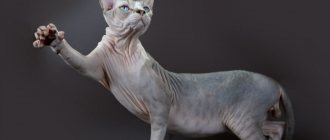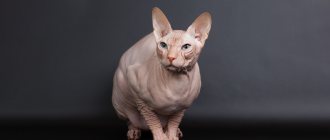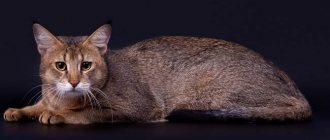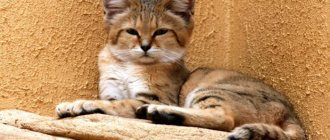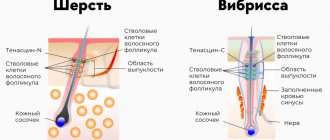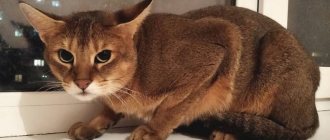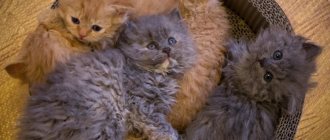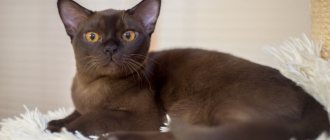The Don Sphynx Brush is the youngest cat breed. But, despite her “youth,” she managed to win the trust and love of many people. It is worth immediately noting that the Sphynx cat breeds differ from others in their kindness and unusual appearance. The Sphynx Brush is not necessarily a hairless breed; there are furry representatives of this amazing species.
The first mention of such a cat was in Rostov-on-Don, where it was said that a woman found an unusual naked cat right on the street. The first kittens did not belong to any breed, so they came up with different names.
Varieties of the Don breed
Representatives of the Don breed are the most diverse in length and density of coat. It is also worth noting a breed peculiarity: in the cold months, hairless cats are covered with short and sparse fluff, and in the warm season they go bald again. There are three types of cats of the Don breed of wool type.
Velor Sphynx
The Don Sphynx of the velor variety has quite long, fleecy hair, which is clearly noticeable when stroking the animal’s body. Fur covers the body from birth, although visually a newborn kitten appears bald.
The furs are hard, puff up when you run your hand against their growth, then return to their original position. A sexually mature Don Sphynx loses a significant part of its fur. Most cats only have their head and limbs covered.
Brush sphinx
If you breed hairless animals, then the combination of dominant genes results in a non-viable litter. Therefore, the Don Sphynx of the Brush variety is the result of crossing hairless and woolly cats. But if you breed two representatives of the brush type, hairless cubs will be born.
A newborn brush kitten is covered with dense, curly hair, which remains or falls out in an adult cat. The external characteristics of the Sphinx Brush are unstable. Representatives of the species are either naked or covered with fur, depending on climatic conditions, diet, and changes in hormonal levels.
The brush variety is characterized by autumn shedding. There are vibrissae, they are curved, which gives the animal a funny look. The coat may be uneven in length and thickness, which gives the Sphynx Brush a somewhat unkempt appearance.
Important! Brush sphinxes have no exhibition value and are not allowed into exhibitions. But they are often used for breeding.
Flock Sphynx
Newborn kittens of the flock variety visually appear bald, but in reality the body is covered with sparse hairs that fit tightly to the skin. To the touch, the flock kitten's body seems velvety.
As the animal grows, the velvet cover becomes thinner and gradually disappears.
Character of the sphinxes
Brush Don Sphynx kittens are very energetic, friendly and love attention. One of the distinctive features is the rapid adaptation to any changes and almost “iron” nerves. This breed is very affectionate and inquisitive.
They are very active and love games. Unlike other types of cats, Sphynx cats prefer to be close to their owner, so they learn and respond very quickly to words “yes” and “no”. The preferred place to rest and sleep is the lap of its beloved owner. They are very peaceful and quickly adapt to homes with other animals.
Dimensions and parameters
The Don Sphynx is a cat with a harmonious and graceful physique and a strong skeleton. With its physique and facial features, the Don pet resembles an alien creature.
Body size is average. Height at the withers is 25–30 cm. The male weighs 6–7 kg, the female – 4–5 kg.
Sphynx brushes are divided into three categories based on the thickness of their coat:
- Velor brush. Hairs up to 5 mm long. In an adult cat, the coat becomes flocked: hairs remain on the neck and body.
- Brush point. A newborn kitten has dense fur. After a year of life, the coat is discharged. Short and dense hair remains on the face and tail. The rest of the body is velor.
- Dense brush. The body is covered with dense wool, through which the skin does not show through.
The Sphynx brush can be any color. The most common are red, black, blue, lilac, white, gray, cream, chocolate, and tortoiseshell cats.
Sphinx cost
If you want to buy a naked kitten, then you should contact professional and competent sellers. Do not buy an animal at the market, because you can not only buy a “foundling”, but also a sick cat. When buying a Sphynx, you need to make sure of several facts:
1) Does the animal have documents?
2) Is it realistic to conclude an agreement?
3) Pay attention to the sanitary conditions at the place of purchase.
4) Carefully examine the kitten's appearance.
5) Find out if the kitten is toilet trained.
6) Make sure your animal is vaccinated.
The Don Sphynx Brush, whose price ranges from 10,000 to 25,000 rubles, is not a cheap breed at all. The cost will depend on the age and specific breed of cats. But this is the price of officially registered nurseries. Expensive? Breeding such a breed is quite difficult and expensive, so you should not bargain or say that it is not worth it. The question should be asked differently: “Is the price really confirmed by the quality of the breed?” The answer can only be given by the breeder himself. But what if the price of ten thousand is too much for you? There is no need to be sad, there is a way out.
The Don Sphynx Brush is also bred by many non-professionals in this field. And you can buy a purebred kitten for 3500-5000 rubles. Of course, it sounds scary, but how do two identical breeds raised in different conditions differ from each other? Nothing, that's the answer. Online advertisements have become a popular option for purchasing. You need to be careful when making such purchases, and it is even better to buy on the official websites of sellers who have all the documents confirming compliance with all standards.
Description of the breed and parameters of the Sphinx Brush
The breed standard for sphinxes is strict. Anatomical and external parameters are shown in the table.
| head | triangular, high cheekbones, narrowed downwards, noticeable brow ridges, flattened forehead, straight nose, prominent whisker pads |
| eyes | medium size, almond-shaped, iris of any possible color for a cat |
| ears | disproportionately large, widely spaced, slightly inclined forward, with a wide base and rounded ends |
| vibrissae | unequal length, curved |
| torso | strong, sinewy, elongated, dignified, harmoniously and gracefully built, with well-developed muscles, straight spine, wide croup |
| limbs | elongated, thin, graceful, oblong paws with long toes |
| tail | long, thin, with a rounded end, without strong bends |
Breed health
The Don Sphynx breed is gentle, but does not have any special health problems. If cats live in good conditions, there will be no special problems. It is important to protect him from cold and sunburn, bathe him promptly and keep him clean.
There are a number of diseases that are characteristic of the Don Sphynx breed:
- hypertrophic cardiomyopathy;
- muscle dystrophy (myopathy);
- airway obstruction.
With hypertrophic myopathy, sphinxes weaken, lose activity, the tips of the nose and paws become bluish. Myopathy begins with the muscles of the neck, then moves to the back and limbs. Cats also die from paralysis. The most common cause of death of the Don Sphynx is airway obstruction.
Unfortunately, the hereditary disease is transmitted in a recessive manner and it has not yet been possible to cope with it. All cats and cats must be vaccinated to protect against infections, and not to treat them subsequently.
Recommended by
Average lifespan
With proper care, the Don Sphynx lives 13–15 years. Obesity significantly reduces life expectancy, which causes diseases of the joints, heart, blood vessels, and digestive organs.
In order for your pet to remain healthy and live a long time, it is necessary to regularly take it to the veterinarian for preventative checks. At 6 weeks of age, the kitten is vaccinated against distemper, calcivirosis and rhinotracheitis.
At the 8th week of life, the pet is given a vaccine against rabies, at the 12th - against leukemia, at the 13th - against chlamydia. A one-year-old kitten is revaccinated, then the vaccinations are repeated annually. Before vaccination, the pet is given tablets to prevent helminthiasis.
Breeding
To breed, you should wait until the female Don Sphynx is fully mature, and this is the time after the third heat.
- The male must also be at least 2 years old.
- After mating has occurred, three weeks later it is clear that the cat is pregnant. The nipples swell and the cat's weight increases.
- The gestation period is about 70 days.
- A cat brings up to 6 kittens. The Don Sphynx cat makes a very caring mother.
Interestingly, the Don Sphynx was used to create a new breed called the Peterbald.
The cat keeps the maternity nest clean. As a rule, she has enough milk in abundance for the entire brood. So the owner of the kittens does not have to manually feed them.
Character of the breed
The Don Sphynx is affectionate, gentle, requiring care and communication. This is a completely non-aggressive animal, but touchy and vulnerable. The Sphynx Brush needs the owner's attention and loves to sit on a person's lap. He can be obsessive when petting him, but quickly realizes that the owner is busy and cannot pay attention to him.
By temperament, the Don Brush pet is sanguine. He is sociable, friendly, inquisitive, non-conflict. If he is not busy with an exciting activity or game, he dozes off in a cozy place.
The Don Sphynx is a wonderful partner for children's games. He willingly participates in children's undertakings, is patient with pampering, and will not allow himself to show aggression towards the child. The Sphinx's attitude towards other domestic animals is loyal and friendly. The pet is ready to share a home with large non-aggressive dogs, and with decorative rodents, and with birds.
Character and behavior
Owners of “bald cats” are convinced that their pets have the highest level of intelligence among domestic cat breeds - it is quite possible that this is so. All Sphynx cats are very affectionate and affectionate cats. They are dog-oriented and interested in their owner, they train well and explore the world around them with great curiosity.
The Sphinx cannot imagine her life without her beloved owner
Loneliness is not for them, keep this in mind if you are planning to get a Sphynx. Donchak dogs are more self-confident and, at least for a short time, will be able to find something to do to pass the time while waiting for the owner. Canadians are very sensitive, withdrawn and fixated on their rich inner world - being left without an owner, they suffer greatly. Peterbalds are emotional, active and will constantly “tell” you about all their activities and fun.
These cats are bright, unique personalities, and this certainly has nothing to do with the type of coat they have. Much more important is whether you can find mutual understanding with them - then your life will become more interesting and sparkle with new colors.
Photo gallery: sphinxes live next to us - interesting facts
They are friendly with pets and seem to consider themselves a bit of a dog.
Sphynxes feel almost no pain and often get burned while warming themselves on a stove or radiator.
They love to dress up and take pictures
The Sphinx is ready to follow its owner everywhere
The hunting instinct of sphinxes is highly developed. They are cunning and gluttons - it is better to hide food from them.
they know how to not only warm their owner, but also treat him. Sphinxes like shiny toys, why is unknown
An uncomfortable or ugly outfit can greatly spoil the sphinx’s mood.
The Sphinx needs to be dressed for walks so that the grass does not cut the delicate skin
Sphynxes love to sleep in the embroidered position - it’s warmer.
Sphynx cats recognize themselves in the mirror; other cats rarely do this.
They say that they understand humor - but they definitely know how to smile!
Care and maintenance
There are no difficulties in caring for the Sphynx Brush. But care must be regular.
| eyes | The teardrops are cleaned daily with a lint-free cloth moistened with boiled water or chamomile infusion |
| ears | clean it twice a week with a cotton swab moistened with veterinary ear lotion, but you should not go deep into the ear with a cotton swab, so as not to injure the internal tissues |
| claws | cut with a nail clipper as they grow, the procedure is carried out with extreme caution so as not to touch living tissue with blood capillaries |
| teeth | Clean 2 times a week with a soft brush using veterinary paste. |
| body | bathing is carried out 2 times a month; to clean the delicate fur of the brush, use baby soap or pet shampoo with an antibacterial effect |
Sphinx food
In this aspect, the Sphynx kitten will definitely please its owner. This cat is an omnivore and is rarely spoiled. She will happily eat the food offered by the owner. The reason for this behavior lies in the increased metabolism due to the lack of fur and high temperature.
In turn, when a kitten greedily grabs pieces of food, you don’t need to think that it needs additional feeding. This is just a characteristic feature of the breed.
There is no need to put your pet on dry or canned food. Here, the combination that provides the necessary vitamins plays a significant role. The main thing is that any food must be of high quality.
Diet
The Donskoy pet must eat a lot, since its body, covered with light brush hair, actively gives off heat, and metabolism in the body proceeds at a high speed. But overfeeding is unacceptable, otherwise the animal will become obese.
You can feed your Sphynx with store-bought food of the premium, superpremium or holistic categories, and with natural products. In the second case, the diet includes:
- lean meat;
- sea fish;
- boiled eggs;
- cereal porridge;
- fermented milk products;
- vegetables.
Note! A kitten up to 3 months old should eat 5 times a day, a six-month-old kitten should eat 4 times, and an adult Sphynx should eat 3 times.
The Sphinx should not be treated to fatty meat, fried food, river fish, bones, smoked meats, pickles, sausages, sweets, bread products, or waste from the master's table.
How much does the Don Sphynx cost?
Without serious health problems, the price of a Don Sphynx ranges from 15,000 to 35,000 rubles. But today you can see an attractive price in advertisements: up to 5,000 rubles. This is not something to be happy about.
If you have seriously decided to get a Don Sphynx, then you should not pay attention to such deceptive advertisements. Most often, under the name of the Don Sphynx, you will be offered an unfortunate sick animal with a fake pedigree. To prevent this from happening, be careful and take your choice of a new household member seriously.
Health
The Donskoy pet Brush is distinguished by good health. But due to his short hair, he is susceptible to colds. Therefore, a brush cat should not be kept in a draft or walked in cool weather.
Representatives of the Don breed have a strong heart, but dermatological pathologies can arise due to illiterate care and an allergic reaction.
The following breed defects are characteristic of sphinxes:
- microphthalmia (abnormally small size of the eyeball);
- shortened lower jaw;
- turning of the eyelids;
- deformation of the caudal vertebrae;
- hyperplasia (proliferation) of the mammary glands;
- vasculitis (cutaneous form).
Attention! A genetic anomaly characteristic of Sphynx cats is the underdevelopment of the thymus gland, which is responsible for the functioning of the immune system. With this pathology, the kitten dies at an early age.
Sphinx-human contact
The love of this cat can be read in his gaze, directed at yours, which radiates truly natural magnetism. Sphynx cats need a sensitive and caring owner who can devote a lot of time and effort to the pet. Hairless cats, in turn, are able to subtly grasp the mood and habits of the owner, trying to build a relationship with him.
If you decide to buy a Sphynx kitten for a family raising a small child, do not worry about it. They will definitely get along great. Sphynxes are ready to share the interests of children and steadfastly endure unintentional rudeness during play, since their skin is very soft and pain-resistant. Cats do not bite or scratch, only occasionally in gameplay.
Choosing a kitten
You should buy a kitten when it is 3 months old. By this age, he becomes strong and independent, knows how to use a scratching post and a tray.
Buy a pet from a nursery or at an exhibition. The seller must provide the buyer with a pedigree and a veterinary passport with entered vaccination data.
A healthy kitten is selected based on the following characteristics:
- friendly, fearless, non-aggressive, lively, inquisitive behavior;
- a well-fed, harmoniously built body;
- clean eyes, ears, nose, anal area;
- elastic abdomen without inflammation and knots;
- soft brush wool that evenly covers the entire body;
- absence of bald spots, traces of parasitic and dermatological diseases.
What factors influence the price
First of all, a hairless cat has certain standards. Consequently, after the kittens are born, they receive a specific class.
- Show. This class is assigned to kittens that meet a whole list of standards. The price is affected by gender, amount of wool, parents.
- Breed. It is appropriate to include in this category those kittens that will be used for breeding in the future.
- Pat. This class is given to kittens born that do not meet any point of the standard. A cat of this class is perfect as a pet. This includes pets that do not have a pedigree.



